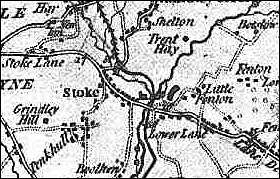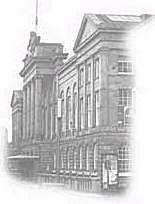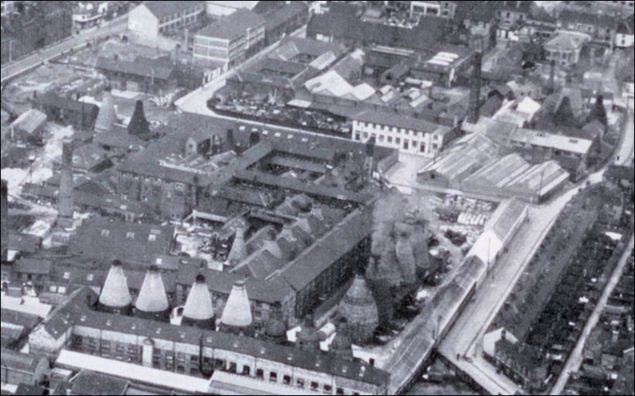|
Stoke is known
for the development of the famous Potteries loop line, the railway
system which once linked the six towns with outlying communities,
Stoke City Football Club and famous pottery manufacturer, Spode
which stood in the centre of the town since 1770.
The town is
currently the administrative centre of the city although moves
are being made to return the civic centre to Hanley.
Charles Dickens
once described Stoke as "a picturesque heap of houses,
kilns, smoke, wharfs, canals and river lying as was most
appropriate, in a basin."
The town of
Stoke has the full name of 'Stoke-upon-Trent' as against the
name of the City (comprising the Six Towns) which is
'Stoke-on-Trent'. This leads to much confusion for visitors who
sometimes think that the extent of the City is the small town of
Stoke. (The main centre is in fact nearby Hanley).
Although Hanley
is the main shopping centre the town of Stoke has dominated in
name by virtue of its ecclesiastical supremacy as the
controlling parish of the area.
The valley setting of Stoke
gave it the early advantage of canal transport and later the
main railway station to serve the area.
|
"STOKE-UPON-TRENT, as its name implies, is pleasantly situated upon that river, in an extensive and populous parish, to which it gives name, about one mile and a half east of Newcastle, upon the sides of the Grand Trunk canal. The town contains many handsome houses, wharfs, warehouses and earthenware manufactories, and is deemed the parish town of the potteries.
The whole parish of Stoke, by the returns for 1821, contained 29,223 inhabitants; and the parish, exclusive of its several extensive dependencies, 3,969 of that number."
1828 journal
"In 1874, Stoke-on-Trent, whose parish includes nearly the whole of the pottery district, was made a municipal borough by Royal Charter, and is now governed by a Corporation consisting of the Mayor, six Aldermen, and eighteen councilors."
1893 journal
Dates in the
history of Stoke
1719
- Thomas Whieldon born in
Penkhull in September.
1749
- Josiah Spode I was apprenticed to Thomas Whieldon, for whom he
worked until at least 1754.
1775
- Josiah Spode II traded in London as a dealer in earthenware, glass
and porcelain. In this year he married Elizabeth Barker and had two sons
(including Josiah Spode III) and three daughters.
1802
- Josiah Spode II installs a steam engine at his works.
1803
- Josiah Spode II built The Mount, Penkhull for his home.
1810
- Josiah Spode II built houses for his factory workers, these
included Penkhull Square, Ten Row, Nine Row and some in Penkhull New
Road.
1834
- Work begins on Stoke Town Hall in Glebe Street (not completed
until 1850) - designed by Henry Ward.
1845
- The North Staffordshire Railway Company ('The Knotty') was
constituted.
1846-
'The Knotty's' first trains ran from a temporary station at Whieldon
Grove to Norton Bridge near Stone.
1874
- Stoke created a borough.
1911
- The King's Hall was built onto the back of Stoke Town Hall.
1927
- The French Michelin Tyre Company chooses Stoke as the site of its
first British factory.
 Dates in the
history of Stoke-on-Trent
Dates in the
history of Stoke-on-Trent
|
Facts about
Stoke from old journals
The Corporation has done much
to improve the district under its control, and few towns in the
kingdom of its size contain so many wide and well-paved streets
and handsome public buildings as Stoke-on-Trent. The town is
admirably lighted by gas, from works the property of the
Corporation; while there is also a copious supply of excellent
water by a private company.
What was properly called Stoke,
until about 70 years ago, [1780] consisted of only five houses,
but the name is now applied to the town, situate at a short
distance to the west, under the lofty hill on which stands the
large village of Penkhull, which appears to be one of the oldest
seats of the earthenware manufacture, for it had three brown
ware potteries in 1600.
Here are several of the largest
porcelain and earthenware manufacturies in the Potteries, and a
commodious range of warehouses and wharfs on the Trent &
Mersey Canal.
Here also are the head offices and
station of the North Staffordshire Railway
 |
|
"Walks"
and articles on Stoke
and the surrounding area |
 Stoke
Road, Howard Place & Snow Hill - 'This road well
travelled deserves a second look'.
Stoke
Road, Howard Place & Snow Hill - 'This road well
travelled deserves a second look'.
|
|
 Winton
Square - the best face of the Potteries.
Winton
Square - the best face of the Potteries.
|
 A
photo walk across Stoke Fields to Winton's Wood - the
parish of St. Simon and St. Jude (Hanley), the area around
Staffordshire University. Winton's Wood and Poxon's field.
A
photo walk across Stoke Fields to Winton's Wood - the
parish of St. Simon and St. Jude (Hanley), the area around
Staffordshire University. Winton's Wood and Poxon's field. |
 Trent Vale,
probably the most important place in Stoke-on-Trent -
From its boundary with the City General Hospital the geography
of Trent Vale is shaped like a triangle with Springfields and
Penkhull in the north falling to the Trent Valley through
Boothen and Oakhill.
Trent Vale,
probably the most important place in Stoke-on-Trent -
From its boundary with the City General Hospital the geography
of Trent Vale is shaped like a triangle with Springfields and
Penkhull in the north falling to the Trent Valley through
Boothen and Oakhill.
|
 Stoke-upon-Trent,
is as it was, motionless - Historically Stoke was an
important stockade and an inland port as far as the currents of
the River Trent could reach, and its physical outlook really
does have more going for it than any of the other five towns
that make up Stoke-on-Trent. So why does Stoke have such a hard
time with its identity?
Stoke-upon-Trent,
is as it was, motionless - Historically Stoke was an
important stockade and an inland port as far as the currents of
the River Trent could reach, and its physical outlook really
does have more going for it than any of the other five towns
that make up Stoke-on-Trent. So why does Stoke have such a hard
time with its identity?
|
 Penkhull:
Josiah Spode & the Mount Estate - A look at The Mount
- home and estate created by Josiah Spode II (1754-1827), master
potter, of Stoke and also to examine the relationship between the
estate and the village of Penkhull.
Penkhull:
Josiah Spode & the Mount Estate - A look at The Mount
- home and estate created by Josiah Spode II (1754-1827), master
potter, of Stoke and also to examine the relationship between the
estate and the village of Penkhull.
|
 Hartshill - 99%
of us will visit.
There was a time when it was essential to have a bit of
class to live in Hartshill. But to be buried there you really had
to mind your place.
Hartshill - 99%
of us will visit.
There was a time when it was essential to have a bit of
class to live in Hartshill. But to be buried there you really had
to mind your place. |
 Colin
Minton Campbell & Hartshill Cemetery
-
The Municipal cemetery reflects Victorian society class
divisions. The cemetery is divided into 4 classes for different
denominations.
Colin
Minton Campbell & Hartshill Cemetery
-
The Municipal cemetery reflects Victorian society class
divisions. The cemetery is divided into 4 classes for different
denominations. |
Stoke
to Newcastle Canal :-
The
Newcastle-under-Lyme to Stoke canal was a 4 mile level canal
from the Trent & Mersey Canal at Stoke to
Newcastle-under-Lyme.
It was authorised by an Act of 1795 and completed in about 1800,
part closed in 1921 and abandoned in 1935 - subsequently filled
in.
It was very little used, except by Spode, Minton and Wolfe whose
pottery works were adjacent to it's Stoke terminal. As a
dividend earner, it was a disastrous failure.
|
|
|
Famous potters
located in the town
have been the Royal
Doulton Minton Works
and Biltons,
the frontage of Minton-Hollins
tile works still stands and is used as offices by a communications
company.
Portmeirion
still manufacture - occupying the Falcon works where Goss china
was made, part of the original factory and bottle kilns still
stand.
Spode
china was produced on the same site in the centre of the town from
1770 to 2009 when the works were closed and the name and pattern
book purchased by Portmeirion.
 List of potters
who were
located in Stoke
List of potters
who were
located in Stoke |

Stoke from W. Yates'
A Map of
the County of Stafford, 1775
- click for bigger map -
 maps on Stoke
maps on Stoke |
|

Stoke Town Hall
Stoke has
had two Town Halls
 on
Stoke's Town Halls
on
Stoke's Town Halls
|

